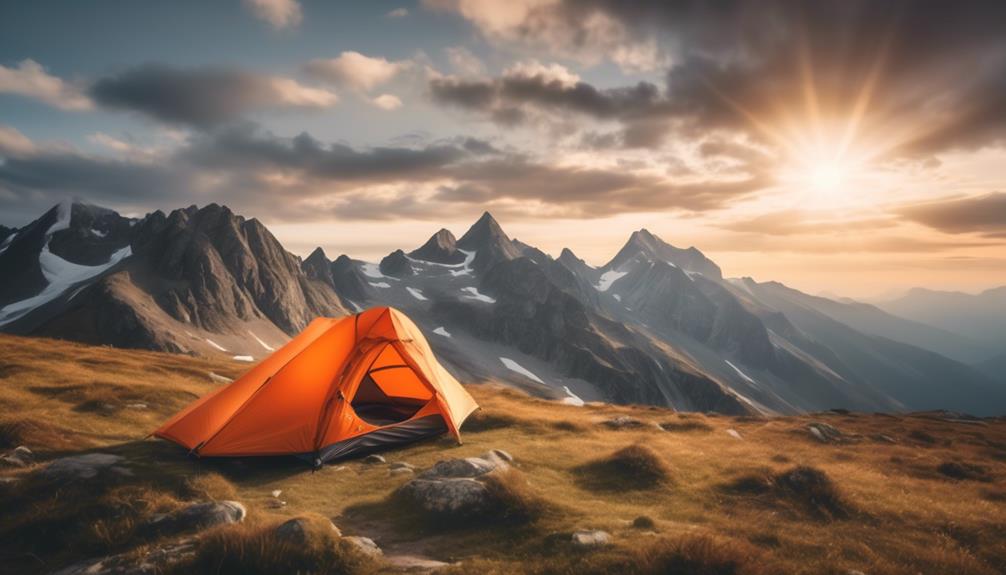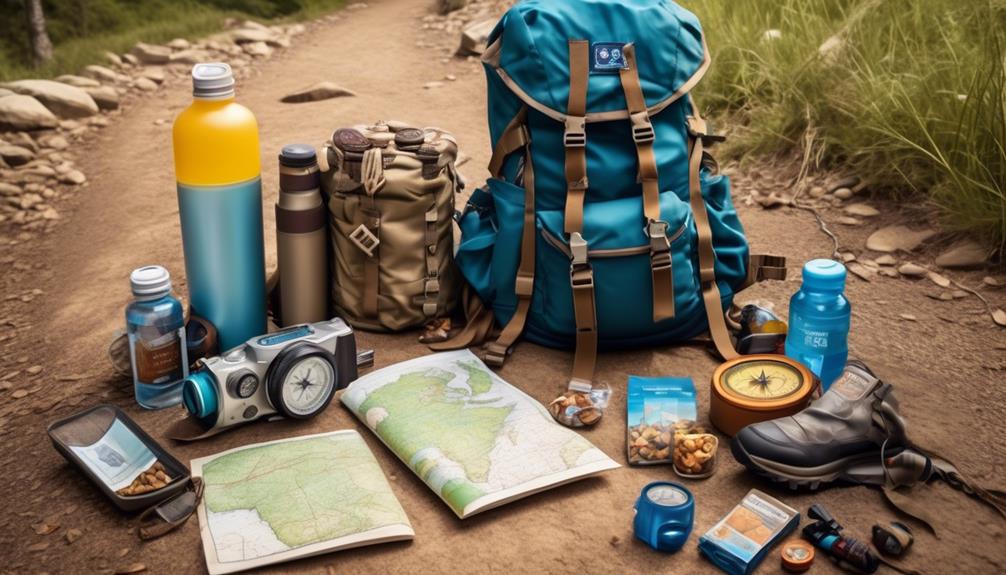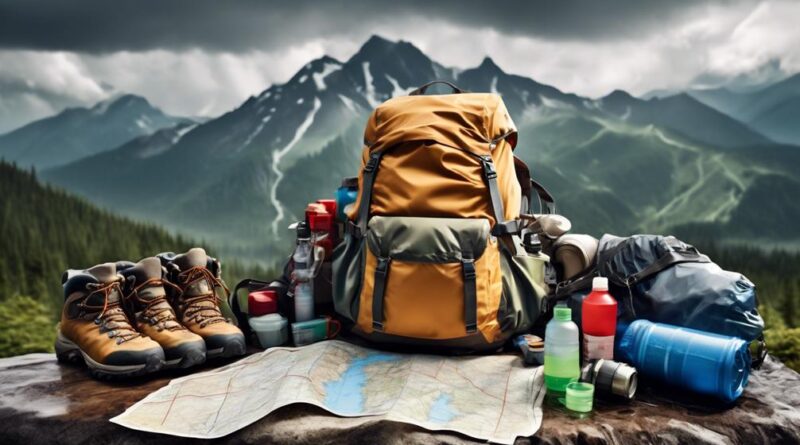What Essential Gear Do Mountain Trekking Beginners Need?
Imagine standing at the base of a majestic mountain, the crisp air filling your lungs as you gaze up at the towering peaks.
As a beginner in mountain trekking, you may be wondering what essential gear you need to embark on this thrilling adventure. From sturdy footwear that can withstand rugged terrain to navigation tools that will guide you through the wilderness, there are key items that will ensure your safety and comfort as you take on the trails.
But what exactly should you prioritize when it comes to gearing up for your mountain trekking journey? Stay with me to uncover the essential gear that will set you up for a successful and enjoyable trekking experience.
Footwear
When planning for mountain trekking, choose sturdy, waterproof hiking boots to provide ankle support and protect your feet from rough terrain. Proper boot fitting is crucial to prevent blisters and ensure comfort during your trek. When trying on boots, wear the socks you intend to use while trekking and ensure there's enough room in the toe box to wiggle your toes. It's essential to walk around in the boots to check for any pressure points or discomfort.
Additionally, consider the traction options available in the boots. Look for outsoles with deep lugs to provide excellent grip on various terrains, including rocky paths and slippery slopes. Some boots also offer crampon compatibility for icy conditions, providing versatility for different trekking environments.
When it comes to traction options, you can choose between boots with Vibram soles for reliable grip and durability, or those with specialized rubber compounds for enhanced traction. Finding the right balance between flexibility and support is crucial, as you'll need to navigate uneven terrain while carrying a backpack.
Moreover, consider the ankle support provided by the boots. Opt for high-cut designs to prevent ankle injuries and provide stability on challenging trails.
Clothing
To ensure comfort and protection during your mountain trekking adventure, selecting appropriate clothing is essential. The layering system is crucial for regulating body temperature and managing moisture. Start with a moisture-wicking base layer to keep sweat away from your skin. Avoid cotton as it retains moisture and can lead to discomfort and chafing. Instead, opt for synthetic or merino wool fabrics that effectively wick away moisture.
The mid-layer provides insulation and should be breathable and lightweight. Fleece jackets or softshell jackets work well for this purpose. Finally, the outer layer should be windproof and waterproof to shield you from the elements. Look for jackets made with durable, water-resistant materials to stay dry and comfortable.
Proper fitting, durable footwear is also paramount. Your shoes or boots should offer ankle support and have a sturdy, well-gripping sole to provide stability on uneven terrain. Ensure that they're properly broken in before embarking on your trek to prevent blisters and discomfort.
When it comes to socks, moisture-wicking materials are again crucial to keep your feet dry and prevent blisters. Invest in good quality hiking socks made from merino wool or synthetic blends.
In addition to the layering system and footwear, consider packing a hat to shield your face from the sun, sunglasses with UV protection, and gloves to keep your hands warm. With the right clothing, you'll be well-prepared to tackle the challenges of mountain trekking.
Backpack

Proper fitting, durable footwear is essential for mountain trekking, and your backpack plays a crucial role in carrying all the necessary gear for your adventure. When selecting a backpack, opt for one with adjustable shoulder straps and a padded hip belt for maximum comfort. Packing tips include placing lighter items at the bottom and heavier ones closer to your back to maintain stability and balance. This helps in preventing strain on your shoulders and back as well as ensuring better weight distribution.
Consider the size of the backpack as well. It should be spacious enough to accommodate all your essentials, but not so large that it becomes cumbersome. Look for a backpack with multiple compartments to help organize your gear efficiently. Additionally, ensure the backpack is made of durable, water-resistant material to protect your belongings from the elements.
When packing your backpack, be mindful of weight distribution. Heavier items like your tent or cooking gear should be placed closer to your back and centered in the pack to maintain stability. Lighter items can be placed towards the top. This will help you maintain your balance and reduce strain on your body during long treks.
Lastly, always check the fit of your backpack. Adjust the straps and hip belt to ensure the weight is evenly distributed and the pack sits comfortably on your back. Taking the time to pack your backpack properly and distribute weight effectively will make your mountain trekking experience more enjoyable and comfortable.
Navigation Tools
Consider including a compass or GPS device in your gear to help you navigate the mountain trails accurately and safely. Whether you're a beginner or an experienced trekker, having reliable navigation tools is essential for staying on course and avoiding getting lost.
Compass skills are fundamental for understanding directions and orienting yourself to the terrain. Learning how to use a compass can be a valuable skill that enhances your outdoor experience.
GPS devices are also valuable tools for trekking, providing accurate positioning and tracking of your route. They can help you pinpoint your location, plan your route, and navigate through unfamiliar terrain with confidence.
Map reading is another crucial aspect of navigation for mountain trekking. Understanding topographic maps and interpreting contour lines can provide valuable information about the terrain's features and elevation changes. It's important to familiarize yourself with map reading and orienteering techniques to effectively navigate the trails. Knowing how to read a map and identify key landmarks can help you stay on track and make informed decisions about your route.
When trekking in mountainous areas, having a combination of navigation tools such as a compass, GPS device, and map can greatly enhance your navigation capabilities. These tools, coupled with the knowledge of compass skills, GPS devices, map reading, and orienteering techniques, will empower you to navigate the trails with confidence and safety.
Shelter

Make sure to pack a sturdy tent for your mountain trekking adventure to provide protection from the elements and a comfortable place to rest at night. When selecting a shelter, consider the weather conditions you may encounter. Look for a tent that's waterproof, durable, and suitable for the terrain you'll be trekking through. It should also be lightweight and easy to set up and dismantle.
It's important to consider the setting up and dismantling shelter techniques before you embark on your trek. Practice setting up your tent at home to familiarize yourself with the process. Look for a tent with a simple and quick setup to save time and energy when you reach your campsite. Additionally, pay attention to how the tent should be dismantled and packed away. Understanding these techniques will make it easier for you to handle your shelter in various weather conditions and terrains.
When it comes to setting up the tent, find a flat and elevated area to avoid potential flooding in case of rain. Clear the ground of any rocks or debris that could damage the tent floor. Ensure that the tent is securely staked down to withstand strong winds.
When dismantling the tent, fold and pack it neatly to make it easier to set up next time. By considering these factors and practicing shelter setup techniques, you can ensure a safe and comfortable night's rest during your mountain trekking adventure.
Hydration
Ensure you stay adequately hydrated throughout your mountain trekking adventure by carrying a reliable water bottle or hydration pack. Hydration is crucial for maintaining your energy and health while trekking at higher altitudes.
Here are some essential tips for staying hydrated during your mountain trek:
- Water purification: Invest in a high-quality water purification system or water purification tablets to ensure access to safe drinking water throughout your trek. Natural water sources may contain harmful bacteria and parasites, so it's essential to purify water before consumption.
- Electrolyte balance: In addition to drinking water, it's important to maintain a proper electrolyte balance. Consider bringing electrolyte tablets or powders to replenish the salts lost through sweating. This will help prevent dehydration and muscle cramps, especially in challenging terrain.
- Hydration monitoring: Keep track of your water intake by setting a schedule to drink at regular intervals. It's easy to forget to drink enough water while focusing on the trek, so a reminder can be helpful.
- Hydration pack: Consider using a hydration pack with a built-in water reservoir and drinking tube. This allows for easy access to water without having to stop and unpack your gear, making it convenient to stay hydrated on the go.
- Weather considerations: Be mindful of weather conditions that can affect your hydration needs. Hot and dry weather may require increased water intake, while cold weather may lead to decreased sensation of thirst, making it easy to overlook hydration.
Nutrition

To maintain your energy levels during your mountain trekking adventure, prioritize packing lightweight and nutrient-dense food options. Meal planning is essential when embarking on a mountain trek. Consider easy-to-prepare meals that are high in carbohydrates, proteins, and healthy fats. Opt for dehydrated or freeze-dried meals that are convenient to carry and require minimal cooking equipment. These meals provide the necessary nutrients without weighing down your backpack.
Additionally, incorporating energy snacks into your meal planning is crucial. Pack nuts, seeds, and dried fruits to keep your energy levels up throughout the day. These snacks are lightweight and provide a quick boost of energy when needed.
When meal planning, focus on foods that are easy to eat on the go and don't require refrigeration. Energy bars and trail mix are great options for quick, on-the-move fuel. They're compact, nutrient-dense, and won't weigh you down.
Consider the duration of your trek and pack enough food to sustain you for the entire trip. It's better to have a surplus of food than to run out during your trek.
Prioritize nutrient-dense options that provide sustained energy to fuel your adventure. With proper meal planning and a selection of energy snacks, you'll be equipped with the nutrition needed to tackle the challenges of mountain trekking.
Safety Equipment
As you gear up for mountain trekking, your safety equipment will be crucial for navigating the challenges of the terrain and ensuring your well-being throughout the journey. Here are the essential safety items you should have with you:
- Emergency Communication: Carrying a fully charged cell phone or a satellite phone is vital for reaching out for help in case of emergencies. Additionally, consider investing in a personal locator beacon (PLB) or a satellite messenger device, which can be invaluable for summoning assistance when you're off the grid.
- First Aid Kit: A well-stocked first aid kit tailored to the specific needs of mountain trekking is indispensable. It should include essentials such as bandages, antiseptic wipes, blister treatment, pain relievers, and any personal medications you may require. Being prepared to handle minor injuries can prevent them from escalating into more serious issues.
- Navigation Tools: Carrying a map of the area, a compass, and a GPS device will help you stay on course and prevent getting lost. Familiarize yourself with these tools before setting out on your trek.
- Emergency Shelter: Packing a lightweight emergency shelter, such as a bivy sack or a space blanket, can provide crucial protection in case you get stranded or encounter unexpected extreme weather conditions.
- Headlamp/Flashlight: A reliable headlamp or flashlight with extra batteries is essential for navigating in low-light conditions or during unexpected nightfall.
Ensuring you have these safety essentials and knowing how to use them will significantly contribute to a safer and more enjoyable mountain trekking experience.
Frequently Asked Questions
Are There Any Specific Tips for Dealing With Altitude Sickness While Mountain Trekking?
When mountain trekking, dealing with altitude sickness is crucial. To prevent it, focus on gradual acclimatization, stay hydrated, and avoid overexertion. If symptoms arise, descend to lower altitudes, rest, and consider medication for relief.
What Types of Wildlife Encounters Should Beginners Be Prepared for in Mountain Trekking?
When mountain trekking, encountering wildlife is possible. Be aware of your surroundings and follow safety precautions. Keep a safe distance, make noise to alert animals, and carry bear spray if needed. Always respect the animals' habitat.
How Can Beginners Protect Their Gear From Extreme Weather Conditions While Trekking in the Mountains?
When trekking in the mountains, protect your gear from extreme weather by using waterproof covers, storing items in dry bags, and regularly checking for damage. Proper gear maintenance and protection are essential for a successful trek.
Are There Any Specific Regulations or Permits Required for Mountain Trekking in Certain Areas?
Before heading out for mountain trekking, it's important to check for any specific regulations or permits required in the area. Different locations may have permit requirements, so research the mountain trekking locations beforehand.
What Are Some Common Mistakes That Beginners Make When Trekking in the Mountains, and How Can They Be Avoided?
When trekking in the mountains, common mistakes include not pacing yourself, ignoring weather forecasts, and not carrying enough water. To avoid them, listen to your body, check the weather, and stay hydrated.
Conclusion
So, as a beginner in mountain trekking, make sure you have the essential gear:
- Sturdy footwear
- Appropriate clothing
- A reliable backpack
- Navigation tools
- Shelter
- Hydration and nutrition supplies
- Safety equipment
With these items, you'll be prepared to tackle the trails and enjoy the beautiful mountain views.
Stay safe, stay prepared, and most importantly, have fun on your mountain trekking adventures!
